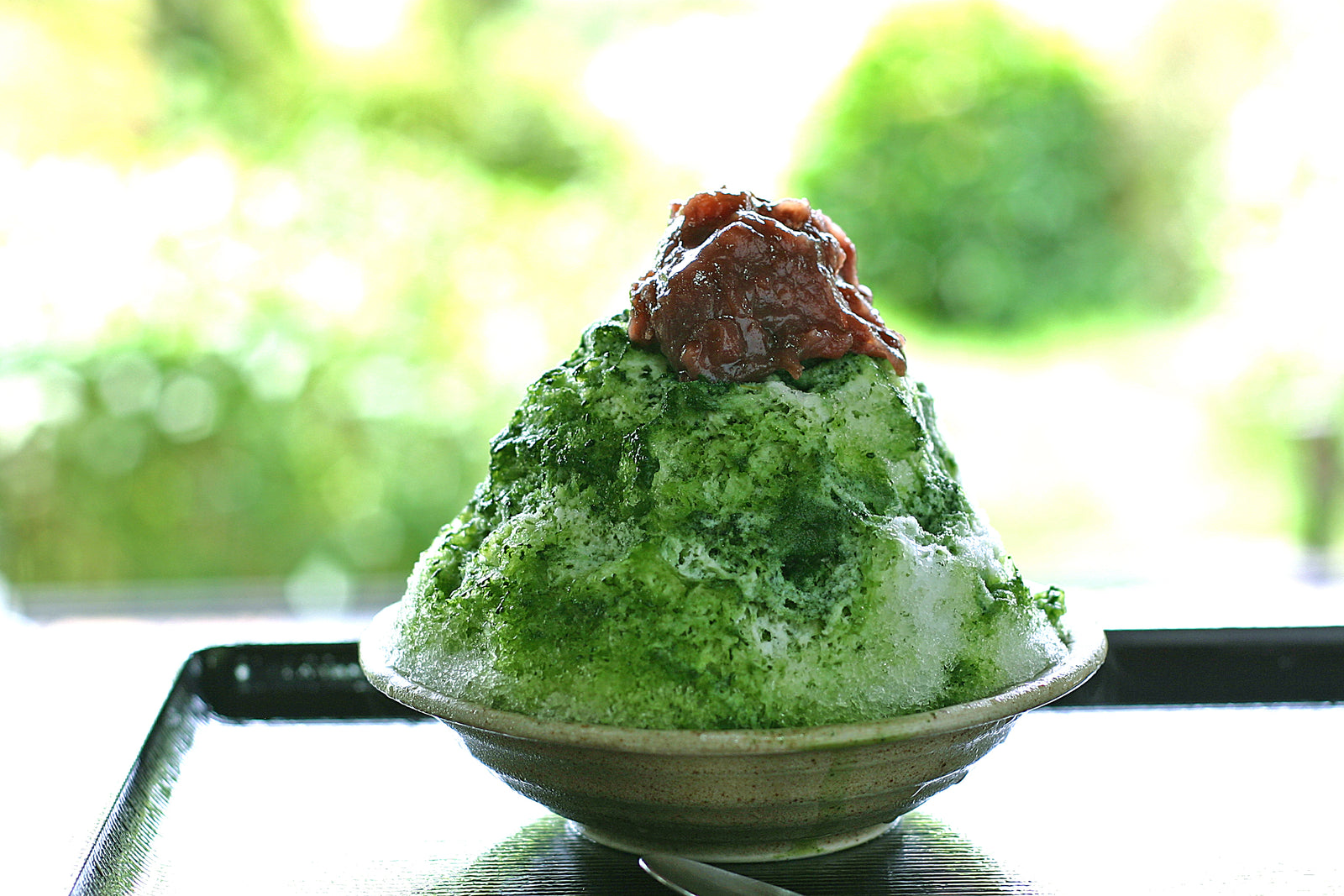日本茶愛好家なら、京都府にある宇治という有名な茶産地の名前は聞いたことがあるでしょう。では、「宇治金時」はご存知ですか?実は、これは日本の伝統的なお茶菓子のこと。上品なひねりを加えた抹茶のかき氷です!
宇治金時は、抹茶シロップと小倉あんをトッピングしたかき氷の一種です。一般的に、かき氷は日本の蒸し暑い夏に欠かせないデザートです。さっぱりとして美味しく、子供たちも大好きです!日本では子供連れの家庭ではかき氷機を持っていることが多いですが、カフェやデザートショップでも楽しむことができます。実は、外で食べるかき氷は特別なんです。シロップは季節のフルーツ濃縮液などを使って特注で作られることが多く、トッピングも独創的です!かき氷のお店によって、ふわふわ、柔らかい、カリカリなど、それぞれに個性があります。
 左; チリーズが撮影したかき氷、右;日本でよく見かけるかき氷の看板。
左; チリーズが撮影したかき氷、右;日本でよく見かけるかき氷の看板。
宇治金時の話に戻りますが、このタイプはおそらく日本の有名なお茶の産地で特によく見られるものでしょう。実際、数年前の8月に京都府和束町で食べた爽やかな宇治金時をはっきりと覚えています。当時、私は有機栽培の茶園で除草作業を手伝っていたので、蒸し暑い休日に自分へのご褒美としてぴったりでした!この珍味に出会える場所によっては、宇治金時にアイスクリームやソフトクリーム、 白玉などがトッピングされていることもあります。私が和束町で食べた宇治金時は、茶葉が飾られていて特別でした!しかし、伝統的な宇治金時は、抹茶シロップと甘い小豆を添えてシンプルに食べます。
 残念ながら、和束滞在中に食べた宇治金時の写真が見つかりませんでした。これは和束茶カフェで現在販売されているものです。この夏、和束を訪れるなら、ぜひ立ち寄ってみてください!写真は和束茶カフェより
残念ながら、和束滞在中に食べた宇治金時の写真が見つかりませんでした。これは和束茶カフェで現在販売されているものです。この夏、和束を訪れるなら、ぜひ立ち寄ってみてください!写真は和束茶カフェより
宇治金時の歴史
宇治金時の起源は詳しくは分かっていませんが、江戸時代にはかき氷に砂糖と抹茶をかけ、その上に餡を乗せて食べられていたと言われています。これは、抹茶に水と砂糖(または甘味料)を加えて作る現在のシロップとは少し異なります。このデザートの発祥については、当時の武将が考案したという説があります。最初の宇治金時は、かき氷にサトウキビシロップを混ぜた抹茶をかけ、その上に餡を乗せたものでした。甘党だった徳川家康によって餡が乗せられたと言われています。
抹茶はいつも宇治産ですか?
宇治金時という名前なので、宇治産の抹茶から作られた抹茶シロップが使われていると思われるかもしれませんが、そうではありません。抹茶の種類に決まりや制限はありません。現在、宇治金時は日本全国で愛飲されており、「抹茶あずき」と呼ばれることもあります。これらはどちらも同じものです。本格的な宇治抹茶シロップを食べたいなら、京都エリアで味わうか、宇治産の抹茶を使ってかき氷とシロップを自分で作るのが一番です。個人的には、小豆を含むすべての材料がオーガニックの宇治金時を探すことをお勧めします。以下は、宇治産のおすすめの抹茶(標準的な儀式用グレード)です。

自家製宇治金時を自分で作ってみよう!
(※ かき氷メーカーが必要になりますのでご注意ください!)
かき氷用の抹茶シロップは、実はとても簡単に作れます。ぜひご家庭でお試しください。お好みの抹茶パウダーをお湯に溶かし、砂糖、蜂蜜、または甘味料を加えずに混ぜるだけです(お好みでどうぞ)。抹茶の風味と香りを最大限に引き出すために、私は甘味料なしの方が好きです。普段通りに抹茶を淹れますが、かき氷の氷が溶けて抹茶の風味が薄まってしまうので、 濃い抹茶(濃い抹茶)にしています。甘い餡子と抹茶を組み合わせると、繊細なかき氷の雪と相性抜群の絶妙な組み合わせになります!
日本では、 甘いあんこを作るのに、缶詰や袋入りの既製のあんこを買ってきて、手間を省くことができます。もちろん、家で作った方が品質は高くなります。私は、砂糖の代わりに砕いたレーズンや刻んだレーズンとクルミを使って、自家製の小豆を作るのが好きです。レーズンを入れすぎたくない場合は、蜂蜜を少し加えてもよいでしょう。
最後にかき氷を作ってトッピングを乗せて、召し上がれ!

静岡県の「茶氷」キャンペーン
最後に、この記事を書いている最中に、静岡県で7月から9月まで実施されている「茶氷」キャンペーンを偶然見つけました。これは、静岡県産のお茶をトッピングしたかき氷のこと。静岡県内の多くの茶店やカフェが、それぞれ趣向を凝らしたユニークな茶氷を考案しています。興味のある方は、ウェブサイトで様々な美しいかき氷をチェックしてみてください!また、静岡県を旅行される方は、蒸し暑いこの時期、かき氷巡りをするのも楽しいかもしれません。最近藤枝に行った際に試したかき氷は、とても美味しかったです。涼しくお過ごしください!
注目の画像:宇治金時(photoACより、 akizou氏撮影)


